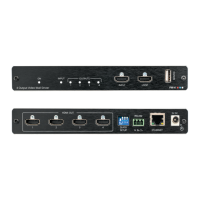Get DHCP mode.
For Backward
compatibility, the id
parameter can be
omitted. In this case, the
Network ID, by default, is
0, which is the Ethernet
control port.
COMMAND
#NET-DHCP?netw_id<CR>
FEEDBACK
~nn@NET-DHCPnetw_id,dhcp_mode<CR><LF>
netw_id – Network ID–the device
network interface (if there are more
than one). Counting is 0 based,
meaning the control port is ‘0’,
additional ports are 1,2,3….
dhcp_mode –
0 – Do not use DHCP. Use the IP
set by the factory or using the
net-ip or net-config
command.
1 – Try to use DHCP. If unavailable,
use the IP set by the factory or
using the net-ip or net-
config command.
Get DHCP mode for port 1:
#NET-DHCP?1<CR>
Set gateway IP.
A network gateway
connects the device via
another network and
maybe over the Internet.
Be careful of security
issues. For proper
settings consult your
network administrator.
COMMAND
#NET-GATEip_address<CR>
FEEDBACK
~nn@NET-GATEip_address<CR><LF>
ip_address – Format:
xxx.xxx.xxx.xxx
Set the gateway IP address to
192.168.0.1:
#NET-
GATE192.168.000.001<CR
>
Get gateway IP.
A network gateway
connects the device via
another network and
maybe over the Internet.
Be aware of security
problems.
COMMAND
#NET-GATE?<CR>
FEEDBACK
~nn@NET-GATEip_address<CR><LF>
ip_address – Format:
xxx.xxx.xxx.xxx
Get the gateway IP address:
#NET-GATE?<CR>
Set IP address.
For proper settings
consult your network
administrator.
COMMAND
#NET-IPip_address<CR>
FEEDBACK
~nn@NET-IPip_address<CR><LF>
ip_address – Format:
xxx.xxx.xxx.xxx
Set the IP address to
192.168.1.39:
#NET-
IP192.168.001.039<CR>
COMMAND
#NET-IP?<CR>
FEEDBACK
~nn@NET-IPip_address<CR><LF>
ip_address – Format:
xxx.xxx.xxx.xxx
Get the IP address:
#NET-IP?<CR>
Get MAC address.
For backward
compatibility, the id
parameter can be
omitted. In this case, the
Network ID, by default, is
0, which is the Ethernet
control port.
COMMAND
#NET-MAC?id<CR>
FEEDBACK
~nn@NET-MACid,mac_address<CR><LF>
id – Network ID–the device network
interface (if there are more than one).
Counting is 0 based, meaning the
control port is ‘0’, additional ports are
1,2,3….
mac_address – Unique MAC
address. Format: XX-XX-XX-XX-XX-
XX where X is hex digit
Set subnet mask.
For proper settings
consult your network
administrator.
COMMAND
#NET-MASKnet_mask<CR>
FEEDBACK
~nn@NET-MASKnet_mask<CR><LF>
net_mask – Format: xxx.xxx.xxx.xxx
Set the subnet mask to
255.255.0.0:
#NET-
MASK255.255.000.000<CR
>
COMMAND
#NET-MASK?<CR>
FEEDBACK
~nn@NET-MASKnet_mask<CR><LF>
net_mask – Format: xxx.xxx.xxx.xxx
Get the subnet mask:
#NET-MASK?<CR>
Get device protocol
version.
COMMAND
#PROT-VER?<CR>
FEEDBACK
~nn@PROT-VER3000:version<CR><LF>
version – XX.XX where X is a
decimal digit
Get the device protocol
version:
#PROT-VER?<CR>
Reset device.
To avoid locking the
port due to a USB bug in
Windows, disconnect
USB connections
immediately after running
this command. If the port
was locked, disconnect
and reconnect the cable
to reopen the port.
COMMAND
#RESET<CR>
FEEDBACK
~nn@RESETok<CR><LF>
Reset the device:
#RESET<CR>
Set auto-sync features.
Sets the auto sync
features for the selected
scaler.
COMMAND
#SCLR-ASscaler_index,sync_speed<CR>
FEEDBACK
~nn@SCLR-ASscaler_index,sync_speed<CR><LF>
scaler_index – Scaler Number – 1
sync_speed – 0, 1 or 2
0 – off
1 – fast
2 – slow
Set auto-sync features:
#SCLR-AS1,1<CR>
Set auto-sync features.
Sets the auto sync
features for the selected
scaler.
COMMAND
#SCLR-ASscaler_index<CR>
FEEDBACK
~nn@SCLR-ASscaler_index,sync_speed<CR><LF>
scaler_index – Scaler Number 1-
Scaler1
sync_speed – 0, 1 or 2
0 – off
1 – fast
2 – slow
Get auto-sync features:
#SCLR-AS?1<CR>
Set the OSD of selected
channel.
COMMAND
#SHOW-OSDout_index,switch<CR>
FEEDBACK
~nn@SHOW-OSDout_index,switch<CR><LF>
out_index – Number that indicates
the specific output:
1
switch – On/Off
0 – Off
1 – On
Set the OSD of selected
channel:
#SHOW-OSD1,1<CR>

